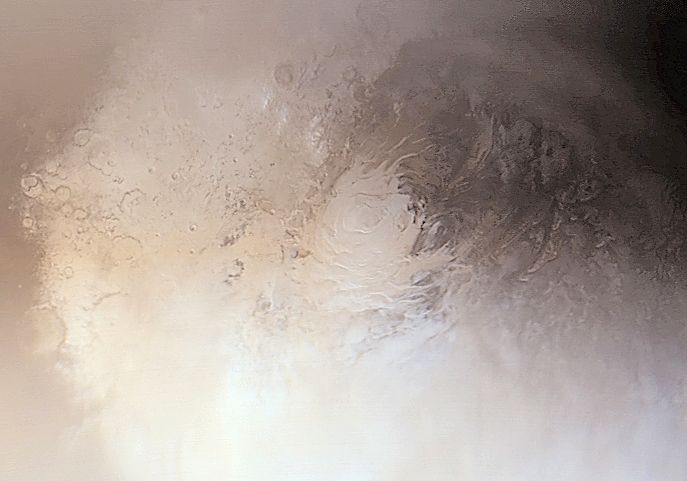Explanation: The south pole of Mars is the bright area near the center of the detailed, subtly shaded color image above. Recorded in September of this year by the Mars Global Surveyor (MGS) spacecraft, the picture shows a region surrounding the 400 kilometer wide martian polar cap in the midst of southern hemisphere spring. During this season the ice cap, predominantly layers of frozen carbon dioxide (dry ice) plus some water ice, begins to shrink as the ices change directly from solid to gas (sublimate). Hazy clouds of ice crystals and fog, extend across the bottom of the picture and a darker, more defrosted area is visible at the upper right, near the Red Planet's night side. A wealth of MGS data has allowed changes in the extent and density of the ice cap to be tracked over time. Now, researchers are also reporting indications that, in addition to seasonal changes, overall the martian southern ice cap has been dwindling in recent years -- dramatic evidence of a changing martian climate. At the measured rate, the increasing amount of carbon dioxide released could gradually raise Mars' atmospheric presure, doubling it over hundreds to thousands of martian years.
1999 2000 2001 2002 2003 2004 2005 2006 2007 2008 2009 2010 2011 2012 2013 2014 2015 2016 2017 2018 2019 2020 2021 2022 2023 2024 2025 |
Yanvar' Fevral' Mart Aprel' Mai Iyun' Iyul' Avgust Sentyabr' Oktyabr' Noyabr' Dekabr' |
NASA Web Site Statements, Warnings, and Disclaimers
NASA Official: Jay Norris. Specific rights apply.
A service of: LHEA at NASA / GSFC
& Michigan Tech. U.
|
Publikacii s klyuchevymi slovami:
climate - ice cap - carbon dioxide - izmenenie klimata - polyarnaya shapka - ledyanaya shapka - uglekislyi gaz - Yuzhnyi polyus - Mars - Mars - south pole
Publikacii so slovami: climate - ice cap - carbon dioxide - izmenenie klimata - polyarnaya shapka - ledyanaya shapka - uglekislyi gaz - Yuzhnyi polyus - Mars - Mars - south pole | |
Sm. takzhe:
Vse publikacii na tu zhe temu >> | |
